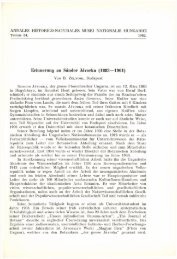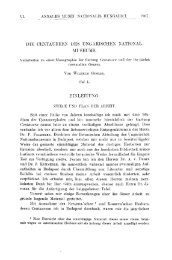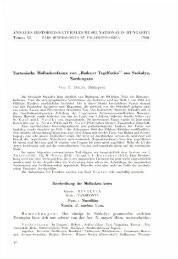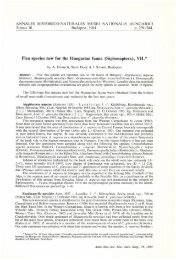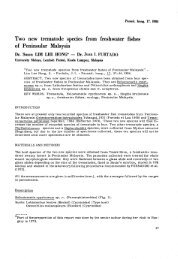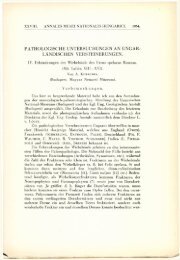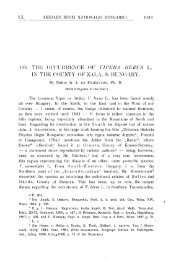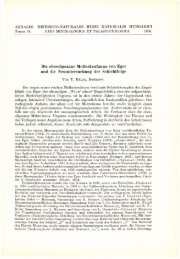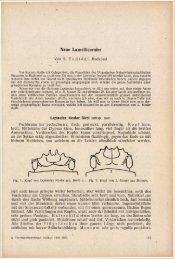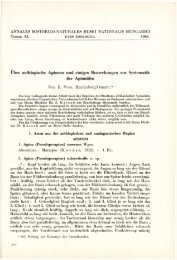Studia Botanica Hungarica 16. 1982 (Budapest, 1982)
Studia Botanica Hungarica 16. 1982 (Budapest, 1982)
Studia Botanica Hungarica 16. 1982 (Budapest, 1982)
You also want an ePaper? Increase the reach of your titles
YUMPU automatically turns print PDFs into web optimized ePapers that Google loves.
a few species of Thymus, Rhinanthus, Achillea, Puccinellia and Koeleria genera have - for the<br />
time being - been left out.<br />
Notes to the<br />
flora<br />
The examined area belongs to the Praematricum flora district of the Eupannonicum floristic<br />
region of the Pannonicum territory which is contiguous with the Cirsicum flora district on the<br />
east and its north-western margin is close to the border of the Neogradense flora district of<br />
the Matricum floristic region (SOÓ, 1960).<br />
The important species found by the author or by the author, too, are as follows.<br />
The Acer tataricum in the juvenile, degraded oak forest ("Hársas") on loess territory<br />
expanding from north-west to the neighbourhood of Albertirsa (the lowland margin of the Gödöllői<br />
dombság), the Melica altissima, which is also associated with the loess oak forest characterized<br />
by Tatar maple, occurs in the cut-over shrubbery ("Hársas").<br />
The Isatis tinctoria of loess relict character rises on the bank of the deep road ("Peres")<br />
cutting across the loess hills; the Amygdalus nana and the pontus-pannonian Inula germanica are<br />
also characteristic species of loess.<br />
The considerably thinned Iris spuria, the Beckmannia eruciformis, which is a constituent<br />
grass of the Crisicum sodic meadows, as well as the Aster sedifolius, indicating the former<br />
forests, rise in meadow solonies soily (VARALLYAY, 1979) sodic area {"Cigányszék") developed<br />
on loess deposit to the north off Cegléd. To the east off here ("Varnyás") I have found Pholiu-<br />
rus pannonicus - which most often occurs in the region of "Tiszántúl" - on similar type of<br />
sodic<br />
area.<br />
The Cicuta virosa which was found on the bank of Gerje canal on the northern part of<br />
Albertirsa (site "A") has to be mentioned by all means. This plant which was considerably<br />
reduced in number on "Alföld" (Hungarian Great Plain), mostly occurs in the West-Transdanubian<br />
bogs as well as in the relict-type bogs of "Eszak-Alföld" (North Great Plain) rich in<br />
relict-type plants similar to Cicuta as well as in the "Beregi-sik" (BOROS, 1962). Its occurrance<br />
in the biotop deteriorated and dissimilar to the above mentioned ones here makes an earlier<br />
probable existance of bogs and fenmeadows rich in species.<br />
On a small "relict"-meadow of the heavily disturbed "Tőzeges" live two characteristic<br />
boggy species Dianthus superbus and Eriophorum latifolium.<br />
Going along Cegléd from its south-east edge to the western side of the town, two smaller<br />
and one bigger (at the western side) - estimated 50-80 000 specimens - Ophrys sphegodes population<br />
can be found. At the southern margin of the town there are two Schoenus nigricans stands<br />
on the brink of ruins, each forms a marginal zone of the draining, reclaimed reed beds.<br />
(Among the expanded rush-beds there are scarcely any plants and which actually do exist are<br />
not messengers of the former fenmeadows).<br />
The infrequent Carex disticha came up from high-sedge community on the western tip of<br />
"Balladiilo".<br />
Finally, I have also recorded the well known endemic species - Colchicum arenaria,<br />
Dianthus diutinus, Dianthus serotinus - and the pannonian Iris humilis ssp. arenaria, which are<br />
known (among others by the excellent works of HOLLOS, BOROS HARGITAI) from the territory<br />
of Nagyerdő in Nagykőrös. In a vegetation regarded by HARGITAI as "ruined" already in 1937<br />
Menyanthes trifoliata - still occuring here ("Gógánydülő" and "Szurdok") at that time but by now<br />
a rarity in Hungary - has alongside with a number of other valuable plants surely become extinct<br />
on the area of examination. (Though I made great efforts at finding Menyanthes, I could not find<br />
it). However, the Thelypteris thelypteroides and the rush-bed of Calamagrostis canescens - also<br />
mentioned in papers - could be found (" Gógánydülő").<br />
The habitat of the Crocus reticulatus is a Natural Protected Area ("Szápári puszta").



